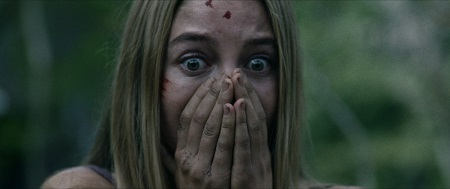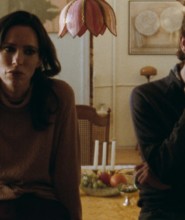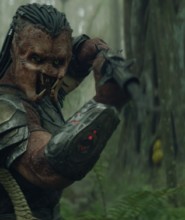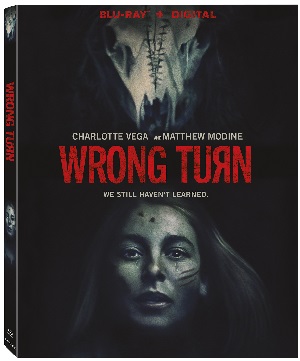
“Wrong Turn” – Interview with Mike P. Nelson
by Sara Michelle Fetters - February 25th, 2021 - Blu-ray and DVD Interviews
Uncomfortable and Challenging
Director Mike P. Nelson on taking a Wrong Turn into the horrifying unknown
After a short theatrical engagement back in late January, director Mike P. Nelson’s reinvention of Wrong Turn makes its home debut this week on DVD, Blu-ray and VOD. Written by Alan McElroy, the scribe behind the 2003 original, this horror offering has absolutely nothing to do with the inbred backwoods West Virginia cannibals of the previous franchise. Instead, it offers up an entirely new mythology with its own characters, quirks and eccentricities, all of it filled with gory deaths and unexpected twists that help make this Appalachian Trail trek into madness worth embarking on.
Back in my original review, I called this remake/reboot a grisly smash that filled my horror-loving heart with glee. On subsequent re-watch, those feelings were only confirmed.
I had the pleasure to chat with Nelson about the making of Wrong Turn. Here are a few edited excerpts from our wide-ranging, and far too brief, conversation:
Sara Michelle Fetters: How in the world does a new Wrong Turn movie come your way, especially one from the writer of the original Wrong Turn, Alan McElroy?
Mike P. Nelson: Maybe a little bit of fate. Noah Rosen, who’s my manager, and who works with Alan quite a bit, sent this to me. He said, “Mike, you’ve got to read this script. It’s pretty crazy, I know it says Wrong Turn on it, but just give it a chance.”
I remember I didn’t read it right away. I was like, “Wrong Turn? What am I getting myself into?” That’s not a series I’d normally consider being a part of. But I did like the first one, so I thought, maybe this could be fun.
So, I read it. I remember getting to that pivotal moment in the [script] where everything changes and just thinking, what in the heck is going on here? It wasn’t what I was expecting.
I didn’t know how to feel in that moment. It was very strange. There was a lot of great build-up to that moment, and then we kind of take this turn into a completely different movie. It was almost like we were starting a whole other three-act structure right in the middle of the movie! I had to screw my head back on again after that and just throw out everything that I knew about how movies should be, or. At least, how I thought a Wrong Turn movie should be.
I remember finishing, just being like, if we can pull this off that would be pretty awesome. I sat with it for a little bit, talked with Alan and made some changes. Then I spoke with [producer Robert Kulzer] and pitched for the movie. The rest is history, as it all just fell together after that.
When you have a group of people like Alan and Robert, people like our DP Nick Junkersfeld, the entire crew, in fact, they understood the movie so clearly. They knew what we were doing. Nobody got cold feet about doing something super crazy, because you can’t go into something like this fearful. They were all all-in and willing to go for it. It was challenging, but also a really cool experience to be able to work with a group of people who believed in doing something so bold.
Sara Michelle Fetters: I almost don’t even know where to begin with everything you just said. I will say I had to go back and watch it a second time, because I was just so gobsmacked from anticipating what the movie was going to be and then having it be something completely different. There is an important visual clue that I think people potentially miss. You show early on that we’re in Virginia and not West Virginia. Was this a clever visual touch? Or a vital piece of information you hoped savvy viewers would clue in on?
Mike P. Nelson: There are a couple things with the Virginia/West Virginia thing. There was a point in the script where it was actually West Virginia. Alan wanted to start the whole lore over again. He loved it being set in Harper’s Ferry, West Virginia. Then we started talking about it.
First of all, we couldn’t shoot in Harper’s Ferry. Next, I started to research, and most of the Appalachian Trail isn’t even in West Virginia; it’s actually in Virginia. Our characters are on the Appalachian Trail for a long time, and there’s only like four or five miles of the trail in West Virginia.
Then the lawyers came in and they were like, wait a second, can you actually say this is West Virginia? Because it’s a new Wrong Turn film, and the other one is from 20th Century Fox. Did we have the rights to use West Virginia as a location?
I think the clouds opened and God spoke to us that it couldn’t be West Virginia. It had to be Virginia. And this actually benefitted the movie. We were not in West Virginia with the cannibals. No, we are in Virginia. We’re with the Foundation.
So, yes, the sign thing was on purpose. Glad you picked up on that.
Sara Michelle Fetters: For me, that was such a nice twist, because it honors and recognizes the original series, which, let’s be honest, after the first two isn’t all that good, but still allows you to go your own way. You get to create your own mythology, your own group of characters, but still acknowledge that the other stories continue to exist in a very subtle way. Even better, by making this clean break, you get to tackle your own set of themes and issues, taking the viewer on a journey into the heart of American cultural mythology, which I think is pretty great.
Mike P. Nelson: Absolutely. What I love about where the film sort of goes and ends up is that our story has an antagonist. It’s maybe not the clearest antagonist, but it has one, and that, I think, is unexpected. But every single person in this movie does some Very Bad Things. And every single person in this movie has a point of view that we can actually respect and relate to, maybe even admire. That’s an uncomfortable place to be. I think with films, stories are easier to digest when we can latch onto a clear villain and a clear good guy. We don’t give the viewer that.
What’s was hard about this group of young adults that go out into the woods is they go out with good intentions. They’re not there to cause trouble. But they still come with baggage. They come with stereotyping, judging baggage toward these people who reside in this area of the country.
That’s where it starts to get tricky. I think we all have a feeling or a prejudice toward certain people, possibly in red states. We’re like, I don’t know about these people, this place, I think we have to stay away because those people might be crazy.
Yet when you’re able to explore the differences of opinion, the differences of worlds where we actually come from and how those collide, then you start to realize that we’re all just people. We’re all making good and bad decisions. Unfortunately, that ends up getting a lot of people killed in this particular situation, otherwise we wouldn’t have a movie.
But there was still something uncomfortable and challenging for me going into telling a story like this one. I’m a child of Indiana Jones. I love those stories. They’re so quick and clear. It’s just boom, boom, boom. Start, middle, climax. The protagonist: a little rough around the edges but still does what’s right. Pretty much that simple.
This wasn’t that. It was challenging. And I know that it’s challenging for audiences, too. It can all get a little bit gray. People who you feel are good actually end up being a little bit cruddy. The people who are kind of bad, or who we think were bad, we start to wonder if they kind of have a point. It just gets hard to tell good from bad, and I loved that about the script. I love that Alan challenged us in that way.
Sara Michelle Fetters: You have a pair of LGBTQ characters who, I must admit, I actually would have liked a little bit more time with, so that they could have been developed just a little more, but who are still of a type we don’t typically see in a horror movie like this one. This also throws people off a little. We want to connect with these guys, and we’re so happy that they’re here, but then, maybe just moments later, it’s a lot like you say, sometimes good people make some really bad decisions.
Mike P. Nelson: A hundred percent. That was something that Alan and I talked about right from the get-go. I think so many movies are guilty of this, in creating an LGBTQ couple or characters and making them caricatures. It’s an easy thing to do.
When I was talking to Alan about this, he said, “You know what? Yes, they’re gay, but guess what? They’re people. Why can’t we just treat them like they’re people in the movie? They don’t need to be stereotypes.” It was so obvious, and it’s so upsetting that depictions like this in horror are considered radical. Why? Why do you have to draw so much attention to characters being gay? Why can’t you just let them act naturally and just be who they are?
They’re two men. They’re in love. They’re with their friends. That’s it. That’s what matters. To me, that’s what grounded that relationship, and it also grounds the whole friendship dynamic with the entire group. It set the tone for how they all interacted. That was super important.
Sara Michelle Fetters: We have to talk about Charlotte Vega. How did you know she was going to be able to anchor this film the way that she does?
Mike P. Nelson: I remember going through casting, and I had a handful of ideas of who I thought could do a really good job. Of course, there were the ginormous names that were put in front of me that would probably never do the film, but I was just kind of like, fine, if you guys want to go after them, that’s okay.
But I had a group of names that I was interested in, and Charlotte Vega was one of them. I remember watching one of her movies, The Lodgers, and I was blown away by her character work. She has some chops. To have somebody of her caliber that would want to do our movie? I knew she could pull this character off.
I had this conversation with the studio, and I was like, we can audition anyone you want, but I’m telling you right now, we’ll be sorry if we don’t cast her. This was an amazing opportunity for us to have an incredible actor in our movie. I stated that I felt people were going to appreciate a better performance than just having the role portrayed by a face they may happen to know from Instagram.
A couple days later, they called me back. They had looked her up. They said, “If you want Charlotte, we’ll go with Charlotte.” That was such a relief. I was like, thank you. I felt so lucky. Not too long after, I was able to talk to her over Skype — she lives over in Barcelona — and I just knew she would be perfect. She just has this thing about her.
One thing that I love about casting people who are interesting is that they’re interesting in their real life. They’re not just actors. There are so many actors who I think, that’s all they are. That’s their everything. That doesn’t do anything for me.
With this cast, what was so cool is they all had these quirks, they all had these things outside of acting that they love. I always ask people what they love to do. Like even Emma Dumont who plays Milla. She’s going to school right now for robotic engineering. Isn’t that cool? Everybody had their thing that was strange, that was wonderful. Stuff you would have never expected. I feel like all that feeds into each character and makes them even more interesting.
Sara Michelle Fetters: We’re sadly out of time, and I don’t really know how to talk about him without spoiling parts of the movie but: Bill Sage. Holy freaking cow.
Mike P. Nelson: [laughs] Bill Sage is a frigging powerhouse. A powerhouse. He just ran with it. We were all floored when he came out and did what he did, especially with the ending. We’ll just leave things at that. But, yeah, oh my god. A powerhouse. And a joy to work with. I love him. Holy buckets.
– This interview reprinted courtesy of the SGN in Seattle







